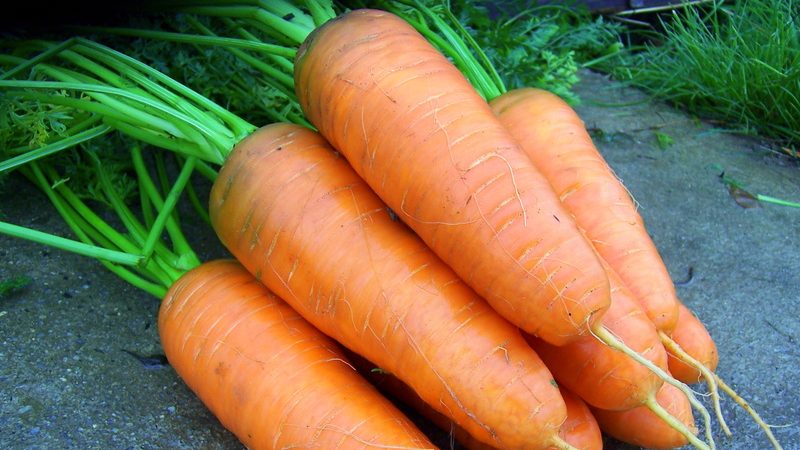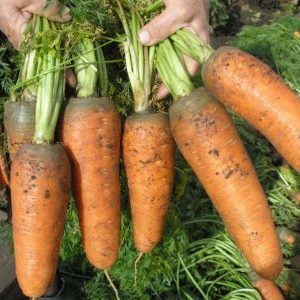Early ripening carrot hybrids: Shantane, Cordoba, Red Core
Carrots are one of the most common vegetables in vegetable gardens. Among the various varieties and hybrids, early maturing are popular, especially in regions with temperate and cold climates. Such crops include the Chantenay variety and the Red Coreed and Cordoba hybrids derived from it.
The content of the article
Description
Carrot variety Shantane 2461 became the ancestor of the variety with smooth, bright orange roots, juicy and sweet in taste. Chantenay varieties ripen quickly, suitable for cold regions. Moreover, such carrots contain the same amount of nutrients as those grown in the south.

Origin and development
Chantanne carrots appeared in the first half of the 20th century in France. It came to our country in the early 40s of the last century, and in 1943 the Chantenay 2461 variety, obtained by selection from French species by Moscow breeders, was brought to the State Register.
In the early 2000s, a hybrid Cordoba was bred from the Chantenay variety in Holland, which in 2007 was included in the State Register of the Russian Federation. The Red Core hybrid appeared in the same country. The official breeder is Nikerson-Zwaan.
Interesting. Other varieties of maternal culture are Shantane Royal, Royal, Comet.
Composition and useful properties
The set of macro- and microelements contained in early carrots is almost ideal, therefore use her all year round.
Root crops are especially rich in such substances:
- potassium - 200 mg per 100 g;
- calcium - 27 mg per 100 g.
Carrots are a low-calorie product: 100 g contains only 35 kcal and 0.15 g of fat. Despite its high density, the vegetable is juicy. Shantane and its hybrids contain a little sugar (6-10%).
Vitamins in root vegetables:
- A - is necessary for growth, improves vision, condition of the skin, hair, nails;
- group B - normalize the work of the nervous, cardiovascular systems;
- C - strengthens the immune system, reduces the severity of inflammation;
- PP - lowers cholesterol, improves coordination and memory, participates in the breakdown of fats and carbohydrates;
- K - prevents hemorrhage and bleeding, restores the skeletal system, normalizes the digestive tract;
- E - has antioxidant properties, improves skin condition.
The vitamin content of carrots does not decrease after heat treatment.
Ripening terms
Chantenay is a mid-early variety: vegetables ripen in 90-110 days. Therefore, when planted in open ground, roots are harvested in July. The greenhouse produces 2 crops per season.
The Cordoba hybrid ripens a little later, after 100–120 days. These are medium late carrots. The growing season of the mid-early Red Core is 100–110 days.
Yield
At Chantenay, the yield is average, 9-10 kg per 1 m2. For hybrids Cordoba and Red Core, this figure is 6-7 kg and 8-9 kg, respectively.
Disease and pest resistance
Chantenay and its cultivars are resistant to rhizoctonia. Wireworms and carrot beetles rarely appear on them.
The Red Core hybrid has strong immunity to powdery and downy mildew, cercosporosis.If the standard agrotechnical methods are not followed, Chantenet is susceptible to fungal diseases.
Improper care of hybrids provokes the appearance of a carrot fly, infection with phomosis.
Specifications

Carrots of Cordoba, Redcore and Chantenay reach a length of 17-22 cm, have the shape of an elongated cone. The variety has strong juicy roots, quite sweet. They contain up to 17 mg of carotene per 100 g of product. The crop has densely folded leaves, making harvesting easier.
Reference. Chantenay has a long shelf life, and Red Core is delicious raw.
For which regions are suitable
Early carrots are cultivated in central Russia. Recommended regions for Shantenay: Central Black Earth, Volgo-Vyatka and Central. The climate of Siberia and Ural allows you to plant this variety, but later in time.
Hybrids Red Core and Cordoba, in addition to those indicated, are zoned for the Far Eastern, Lower Volga, North Caucasian regions.
Advantages and disadvantages
The main advantages of Chantenay, Red Coreed and Cordoba:
- early maturity;
- high productivity;
- long-term storage;
- disease resistance;
- undemanding care;
- attractive presentation of root crops;
- juicy sweet taste of carrots;
- versatility in cooking.
There are practically no significant shortcomings in early carrots.
Differences from other varieties
Cordoba, Red Core and the original Chantenay variety are particularly frost-resistant, so they are planted in early spring.
Usually, early ripening carrots are not suitable for storage, but Chantenay and its hybrids are an exception.
Features of planting and growing
Depending on the ripening rate of the carrots, planting seeds and growing vegetables are different.
Preparing for landing
For the culture to sprout faster, the planting material is pre-soaked in clean water for 2-3 days, then germinated in a damp warm cloth.
Hybridseed Red Cored and Cordoba carrots do not disinfect: the manufacturer took care of this. Before soaking, Chantenet grains are disinfected in a weak solution of potassium permanganate.
With this method of preparation, the first shoots appear after 7-10 days, and the weeds do not have time to drown the shoots.
Ground requirements
Chantenay and her hybrids love well-aerated soil. The best option is loam, peat or sandy soil... By acidity, choose a slightly alkaline or neutral composition. The acidic soil is preliminarily limed.
Predecessors
The best predecessors for early carrots: onions, cabbage, cucumbers, potatoes, tomatoes, zucchini. It is especially good if previously fed organic fertilizers.
The culture is not planted for 2 years in a row in the same place: there is a high risk of pest damage to root crops. This vegetable doesn't like to grow after peas, beans, lettuce, celery, parsnips, and parsley.
Timing, scheme and landing rules

Early carrots are not particularly sensitive to cold weather, so they are planted at the end of April. 2 days before sowing, the beds are watered abundantly. Seeds are placed in furrows 2-3 cm deep. Row spacing is left at 40-50 cm. The distance between the grains is about 2 cm.
There are 3 crop planting schemes:
- Flat - the rows are formed on a flat bed, the seeds are planted evenly. With this method, moisture is retained.
- String - the seeds are planted along the ridge of the garden bed. It is more convenient to weed this way, but when watering and feeding, the liquid flows down.
- High - designed for planting carrots in elevated areas. They form deep rows and bury seeds in them. The method is convenient for controlling watering.
Growing features
The soil in which the carrots grow is regularly loosened. Otherwise, crusts form on the surface of the soil, due to which the roots are bent. They loosen the ground after watering or rains, letting it dry out a little.
The nuances of care
Care for early ripe carrots is standard: vegetables are regularly watered, fertilized, weeded.
Watering mode
The plants are moistened once every 2-3 days, otherwise the vegetables will taste bitter.Water should penetrate 25-30 cm deep into the soil. As the root crops grow, watering is reduced, and 2-3 weeks before harvesting, they stop so that the vegetables do not crack.
Important! In rainy weather, the crop is not irrigated to avoid waterlogging. In the heat, the frequency of watering is increased up to three times a week (even for large root crops).
Thinning and weed control
Plants are kept at a distance of 4–7 cm from each other. Planting begins to thin out after emergence, leaving the strongest shoots.
Carrots need constant weeding. Do this even before the sprouts appear. Weeds take nutrients from the soil, as a result, the roots do not grow to the required size, lose their juiciness, and become tough.
Top dressing
Fertilize Chantenay, Cordoba and Red Core twice a season: during the formation of the first leaves and 30 days after.
For feeding, one of the substances is added to 10 liters of water:
- nitrophosphate - 15 g;
- ash - 400 g;
- saltpeter - 20 g;
- urea - 15 g;
- superphosphate - 30 g.
The resulting solution is applied to the soil during watering. For every m2 enough 5 liters.
Disease and pest control
Early hybrids are affected by insects and diseases if the rules of crop rotation, care and planting density are not followed.
Frequent diseases and pests:
- Carrot fly. The insecticide "Inta-Vir" is used against it. One tablet is dissolved in 10 liters of water, and the plantings are sprayed with the resulting solution. After two weeks, the treatment is repeated.
- Root rot. Affected plants are sprayed with a 1% solution of copper sulfate.
- Alternaria. Vegetables are watered with biological fungicide "Alirin-B": two tablets are dissolved in 10 liters of water.
Harvesting and storage

Depending on the planting time, the carrots are harvested in August or September.
How and when to collect
The harvest period for crops grown in the open field begins 3–3.5 months after sowing. In dry weather, the roots are carefully pulled out, holding the tops.
By the way. When planting deeply, the tops sometimes break off. In this case, use a pitchfork.
Storage features and keeping quality
Carrots planted in spring are stored for 7-8 months after harvest. First, the root crops are cleaned of the ground and dried well, after which the tops are cut off, leaving no more than 0.5-1 cm. The vegetables are laid out in boxes.
Storage conditions:
- temperature - within 0 ... + 5 ° C;
- humidity - 85–95%;
- poor air circulation in the room.
Root crops damaged by a pitchfork or a shovel are placed in a separate box and used first.
Growing difficulties
Despite the unpretentiousness of early carrots, when growing it, vegetable growers face a number of problems.
Usually difficulties arise due to improper planting care:
- Curved roots. The main reason for this is inappropriate watering regime. Vegetables deform if the soil is first dry and then watered abundantly for several days. The culture does not develop properly in rocky soil. During the formation of vegetables, nitrogen fertilizers and fresh manure should not be applied.
- "Hairiness" of carrots... This is a consequence of irregular watering and poor soil. Such vegetables will not lose their taste, but they are no longer subject to long-term storage.
- Bitter taste... The reason lies in the wrong agricultural technique, when the top of the root crop is exposed. The result is solanine, which gives it bitterness. To avoid this, the carrots are regularly huddled, and the tops sticking out of the ground are sprinkled with earth. Another reason is late harvest.
Tips from experienced gardeners
Carrots are an unpretentious crop, but gardeners have their own tricks for growing it:
- The vegetable is planted next to onions or calendula to protect it from pests.
- Water the plantings in the evening, when the tops wilted. Stop irrigation as soon as you smell fresh carrots.
- For fertilization, use a sleeping infusion of black tea.
- Ripe root crops are harvested in stages: first, they pull out a few pieces for food, thereby thinning the garden. The remaining vegetables will grow faster and get more nutrition.
- The harvest is stored in boxes, sprinkling the layers with sand. Instead, moss, onion peels are suitable.
Reviews
Vegetable growers consider the Chantenay variety and the Red Coreed, Cordoba hybrids to be among the best for growing in gardens.
Stanislav, Kirov region: “I have been planting Chantenay carrots for several years. It is easy to grow, and the harvest is fully consistent with the description. I like that it ripens quickly, very tasty. Having tried different varieties, I settled on this one ”.
Alisa, Yaroslavl: “I love early varieties because they are juicy. More juice is obtained from such carrots. I also like its size and shape very much: vegetables are easy to peel. "
Tatiana, Chelyabinsk region: “I am a beginner gardener, so it was important for me that the beds were easy to care for. I tried to plant Red Core. I was very pleased! The carrots grew smooth, large, juicy in taste. Using the advice of experienced summer residents, I saved part of the harvest for the winter. "
Conclusion
Carrots of the Chantenay variety, Cordoba and Red Core hybrids are ready for harvest within 100–110 days after planting. The culture is grown in many regions of the Russian Federation. Root crops are sweet and juicy, attractive presentation.
Caring for vegetables is standard; when all agricultural measures are carried out, the varieties are not susceptible to diseases and pest attacks. The harvested crop is stored all winter.